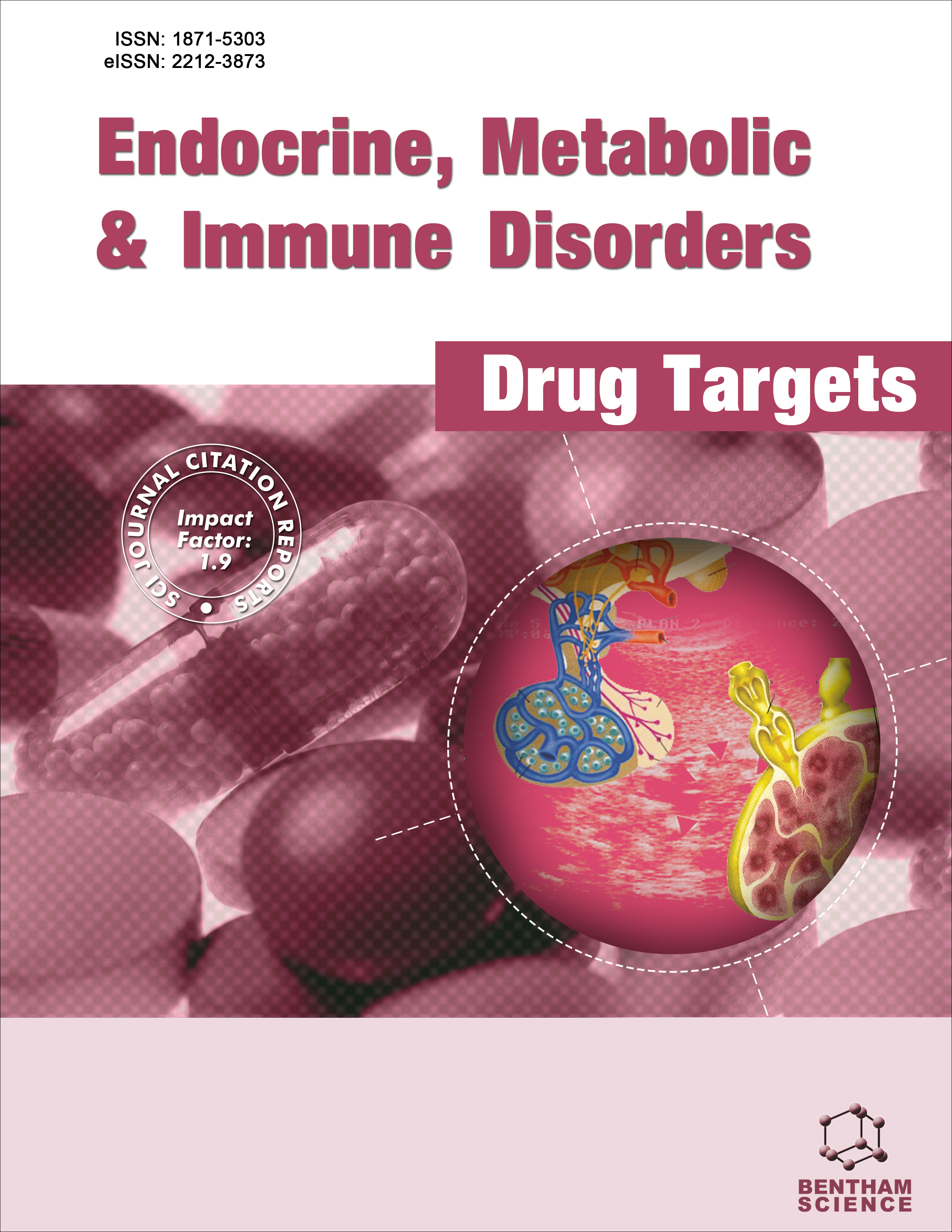- Home
- A-Z Publications
- Endocrine, Metabolic & Immune Disorders-Drug Targets (Formerly Current Drug Targets - Immune, Endocrine & Metabolic Disorders)
- Previous Issues
- Volume 22, Issue 13, 2022
Endocrine, Metabolic & Immune Disorders-Drug Targets (Formerly Current Drug Targets - Immune, Endocrine & Metabolic Disorders) - Volume 22, Issue 13, 2022
Volume 22, Issue 13, 2022
-
-
A Chronic Inflammatory Inductive Condition in the Nursing Profession: A Scoping Review
More LessBy Elsa VitaleBackground: Literature focuses on the well-being of patients and little on the wellbeing of nurses who, in turn, should be educated about well-being. On the other hand, the latter often work under serious pressure with inadequate resources and shift organizations, exposing them to health risk factors. Objective: To highlight which relationships exist between diet, physical activity, body mass index (BMI) and mental health in nursi Read More
-
-
-
Eating Disorders and Type 1 Diabetes: A Perspective
More LessPatients with type 1 diabetes (T1D) are at risk of clinical eating disorders (EDs) and disordered eating behaviors (DEBs) than the general population. This burden is related mainly to diabetes-related physical and psychosocial issues especially beginning during childhood. DEBs must be investigated carefully and promptly managed in case of suspicion, as they can evolve into severe clinical EDs over time and are strictly related to po Read More
-
-
-
Neuroendocrine Modulation of Food Intake and Eating Behavior
More LessBackground: In the first section of this review, we examined the neuroanatomical and neurochemical data on hunger and satiety centers, glucose receptors, sensorial influences on eating behavior, and regulation of energy requirements. The second section is devoted to orexigenic and anorexigenic hormones. Objective: This paper aimed to overview and summarize data regarding the role of neuroendocrine regulation Read More
-
-
-
Pharmacogenomics of Antihypertensive Drugs in Brazil: Recent Progress and Clinical Implications
More LessBackground: The available antihypertensive drugs are effective and well tolerated agents. However, only about half of patients with treated hypertension achieve appropriate blood pressure control. Genetic and non-genetic factors contribute to the interindividual variability of the therapeutic response. Objective: This review constitutes a comprehensive update of the pharmacogenomics of antihypertensive drugs a Read More
-
-
-
Grape Phytochemicals and Vitamin D in the Alleviation of Lung Disorders
More LessBy Kazuki SantaBackground: Typical lung diseases are pneumonia, asthma, sleep apnea syndrome (SA), interstitial pneumonia (IP), lung cancer, and chronic obstructive pulmonary disease (COPD). Coronavirus disease 2019 (COVID-19) is a type of viral pneumonia. Many researchers have reported that phytochemicals (chemical compounds produced by plants) and vitamin D are useful in stimulating our immunity. This review discusses t Read More
-
-
-
Sex-Related Differences Linked to Depression Disorders and Chronic Inflammation Diseases in Nursing Shift Workers: An Expsloratory Multidimensional Literature Review
More LessAuthors: Calabrò Antonino, Elsa Vitale and Lorenzo BardoneObjective: The objective of this literature review is to explore how depression and inflammatory conditions relate to gender among nurses working shifts. Methods: Relevant studies available on the PubMed database over the past decade were consulted. The main keywords were: “shift nurses”, “depression”, “gender Shift Nurses”, “Gender Role”, “shift nurse”, “gender roles”, “Inflammation” and then, free terms were combined Read More
-
-
-
Correlations between Insomnia and Sex, Work Experience, Shift and Body Max Index in Italian Nurses: A Scoping Profile Statement
More LessBy Elsa VitaleAim: The present study aimed to assess any association existing between insomnia according to sex, work experience, shift and BMI values in Italian nurses. Methods: An “ad hoc” questionnaire was created and administered online in October 2020. Data collected included: sex, years of work experience, shift work per day, BMI values, and insomnia levels. Findings: A total of 341 Italian nurses were enrolled. Of these, 277 Read More
-
-
-
A Multi-professional Approach for Transition of Care at Discharge in Hyperglycemic Inpatients with COVID-19: A Single Center Study
More LessBackground: The discharge from the hospital of insulin-treated hyperglycemic patients is always challenging. This is even more so in patients requiring glucocorticoid treatment, such as those with COVID-19. Patients and Methods: A retrospective monocentric study of 23 inpatients was conducted with newly diagnosed or already known diabetes mellitus (DM) who were naïve to insulin treatment, and who were hospitalize Read More
-
-
-
Nurse-led and Interdisciplinary Secondary Cardiovascular Prevention Programmes: Spanish Cohort of the EUROACTION Project
More LessBackground: Cardiovascular prevention and rehabilitation programmes (CVPRP) are a preventive tool, which can reverse unhealthy behaviours and improve risk factor management. They have been successfully implemented in a variety of settings in patients with coronary heart disease (CHD). Objective: The objective of this study is to evaluate an interdisciplinary and nurse-led cardiovascular prevention and rehabilitation progr Read More
-
Volumes & issues
-
Volume 25 (2025)
-
Volume 24 (2024)
-
Volume 23 (2023)
-
Volume 22 (2022)
-
Volume 21 (2021)
-
Volume 20 (2020)
-
Volume 19 (2019)
-
Volume 18 (2018)
-
Volume 17 (2017)
-
Volume 16 (2016)
-
Volume 15 (2015)
-
Volume 14 (2014)
-
Volume 13 (2013)
-
Volume 12 (2012)
-
Volume 11 (2011)
-
Volume 10 (2010)
-
Volume 9 (2009)
-
Volume 8 (2008)
-
Volume 7 (2007)
-
Volume 6 (2006)
Most Read This Month
Article
content/journals/emiddt
Journal
10
5
false
en


